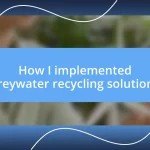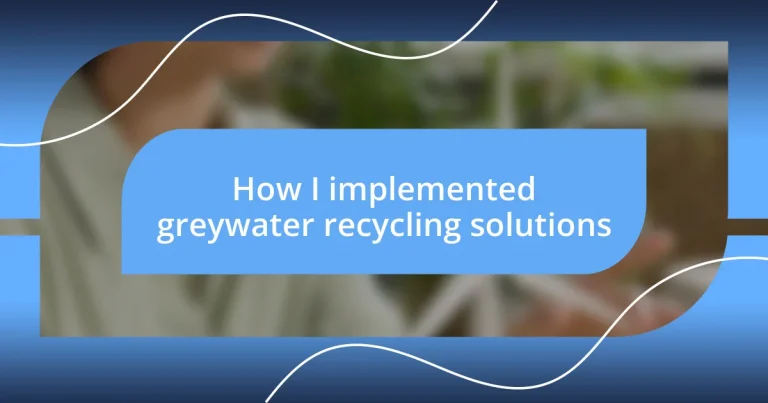Key takeaways:
- Greywater recycling can significantly reduce household water bills, enhance landscaping, and alleviate strain on local wastewater systems.
- Careful planning and evaluation of greywater sources, as well as understanding local regulations, are essential steps for successful implementation.
- Regular maintenance and monitoring are crucial for the efficiency and longevity of greywater systems, preventing potential issues before they escalate.
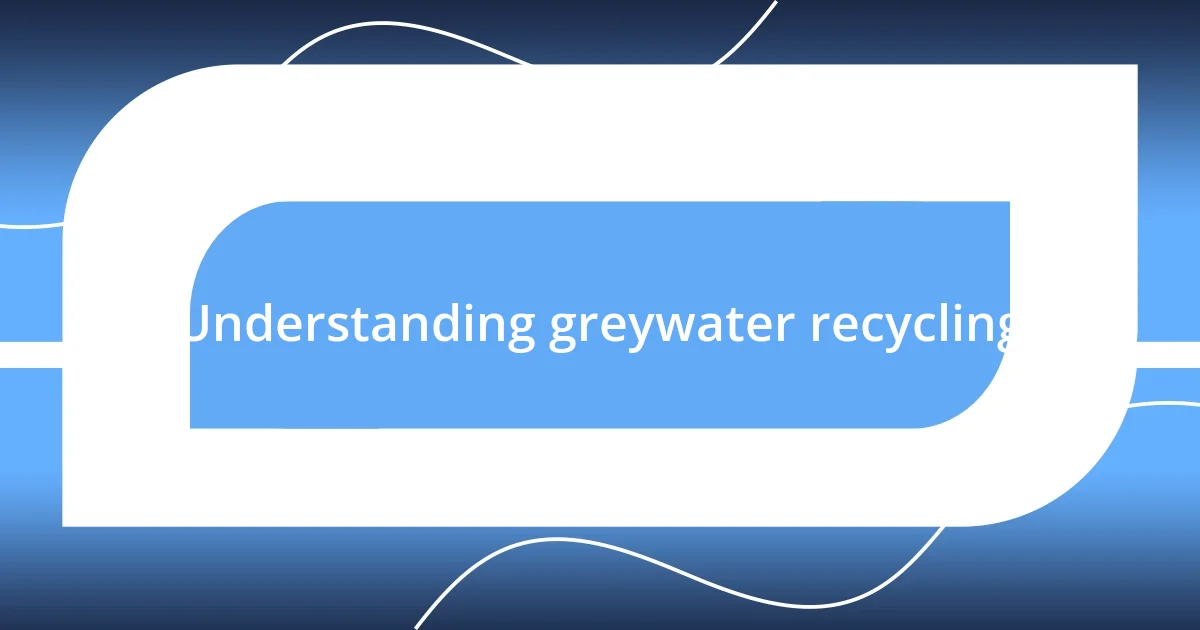
Understanding greywater recycling
Greywater recycling refers to the process of reclaiming water from sources like sinks, showers, and washing machines for reuse in non-potable applications, such as irrigation or toilet flushing. When I first learned about it, I felt a spark of excitement, realizing how much water could potentially be saved and reused. It’s astonishing to think that almost 60% of household water can fall under this category, simply waiting for us to tap into its potential.
As I delved deeper into the topic, I couldn’t ignore the emotional connection we all have to water. It’s the lifeblood of our homes and communities. I remember looking at my modest backyard and picturing how my greywater system could transform it into a thriving garden, using water that would have otherwise gone down the drain. Have you ever considered how much we take clean water for granted? Implementing a greywater system not only makes logical sense but also promotes a profound respect for this precious resource.
Understanding the different types of greywater and their treatment options is essential. For instance, a simple filtration system can help clean the water enough for irrigation, while more advanced setups might include biological processes to ensure safety and efficiency. The more I explored these options, the more I appreciated the nuanced balance between nature and technology. It’s an enlightening journey, reminding me that even small changes in our water usage can make a significant impact on our environment.
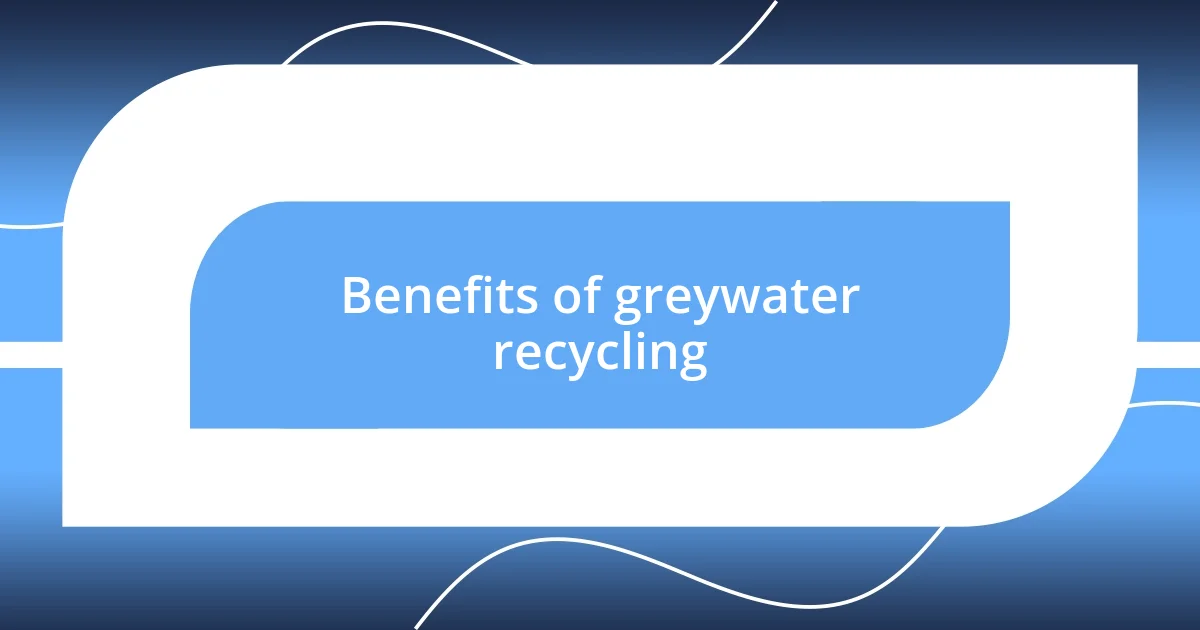
Benefits of greywater recycling
The benefits of greywater recycling extend far beyond just saving water. For instance, I noticed that our water bills decreased significantly once we implemented a basic greywater system. Watching my outdoor plants flourish with the reclaimed water filled me with a sense of achievement. It’s rewarding to know that I’m contributing to conserving a vital resource while also enhancing my home’s landscape.
One undeniable advantage is that greywater recycling can help alleviate the strain on local wastewater systems. When I learned that urban areas can face challenges due to excess water post-treatment, I felt compelled to act. By reusing this water, I not only reduce my own consumption but also lessen the burden on municipal facilities. Did you know that this can lead to fewer infrastructure upgrades in those systems that we often take for granted?
Moreover, greywater systems often improve the overall health of plants by providing them with nutrient-rich water. I could see the difference in my garden’s vibrancy and growth over just a few weeks. My heart swells with pride every time I harvest vegetables grown with recycled water, knowing I played a part in a sustainable cycle of life.
| Benefits | Personal Experience |
|---|---|
| Water Conservation | Noticed significant savings on water bills. |
| Alleviating Strain on Waste Systems | Reduced pressure on municipal wastewater systems. |
| Enhanced Plant Health | Garden flourished with nutrient-rich recycled water. |

Initial assessment and planning
When I decided to explore greywater recycling, conducting a thorough initial assessment was crucial. I found it helpful to first identify the sources of greywater in my home. This step not only clarified what I could potentially reuse but also sparked a curiosity about how much water flows from everyday activities. It surprised me to learn that these seemingly small water streams add up to a significant quantity.
Here are some key factors I evaluated during my planning phase:
- Source Identification: Pinpointed which appliances produce greywater.
- Volume Assessment: Measured the approximate quantity of greywater generated daily.
- Quality Analysis: Evaluated the cleanliness and usability of water from each source.
- Regulatory Compliance: Researched local regulations regarding greywater reuse.
- System Requirements: Determined the necessary equipment for treatment and storage.
Planning led me to visualize the potential impact this system could have. I can still picture the shock on my friends’ faces when I explained how we could reduce our water footprint and contribute to environmental sustainability. It felt like stepping into an entirely new way of thinking about water—transformative and empowering. Each factor I considered fueled my motivation, aligning my actions with my values.
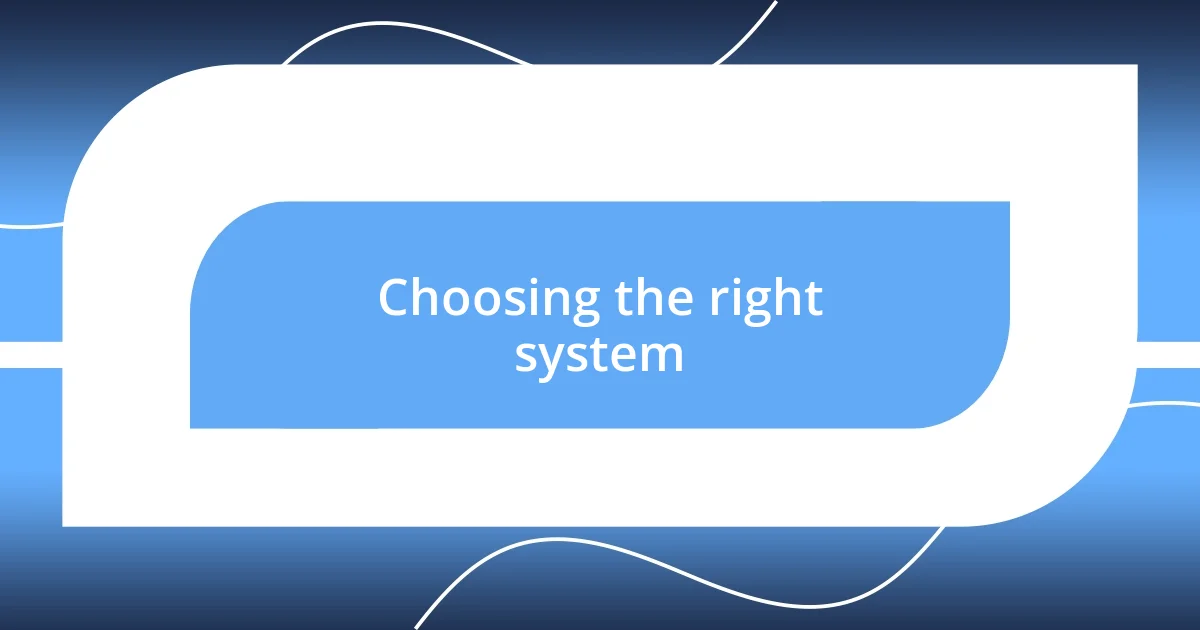
Choosing the right system
Choosing the right greywater recycling system is a pivotal step in the entire process. I remember standing in my backyard, contemplating the options, and thinking, “What truly fits my lifestyle?” Initially, I leaned toward a simple gravity-fed system, but after considering the layout of my property and the volume of water I wanted to reclaim, I realized a more advanced pump system would better meet my needs. Was I ready to invest a bit more for efficiency? Absolutely!
Then there’s the matter of system maintenance. I’ve learned firsthand that a low-maintenance system might seem appealing, but it doesn’t always provide the best efficiency. There’s a balance to strike. I recall a friend opting for a basic model and struggling with blockages—which led to further costs and headaches. It made me appreciate that while the initial price tag is important, the long-term care and reliability of the system are vital in deciding what to choose.
It also pays to consider the environmental and aesthetic impacts of the system. Would I want a visual eyesore in my garden? Certainly not! After researching, I found systems that not only worked well but blended seamlessly with my landscape. I can still picture the relief and excitement when I installed a setup that matched my gardening style—functionality didn’t have to sacrifice beauty. The takeaway here is to choose wisely; it impacts not just your water usage but also how you feel in your space!
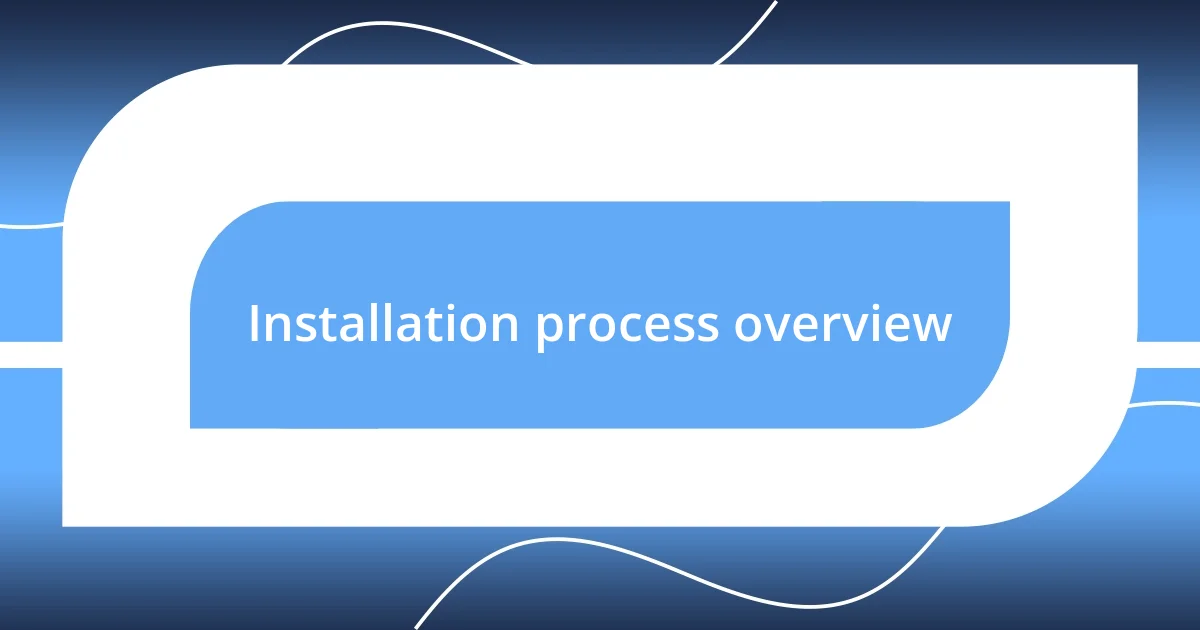
Installation process overview
The installation process for my greywater recycling system began with careful preparation. I vividly remember gathering all the necessary tools and components, mapping out where everything would go. The excitement was palpable; finally, the vision I’d worked so hard to create was about to take shape. Once I started, I followed a clear sequence: first, laying out the piping, then connecting it to the designated sources. Did I feel a hint of nervousness? Certainly! But that anticipation made every step incredibly satisfying.
One of the most crucial moments during the installation was ensuring proper filtration. I still recall a conversation with a friend who had skipped this step and faced some unpleasant blockages later on. Investing time upfront to install a high-quality filter turned out to be a wise decision. I felt a sense of pride knowing I was actively preventing potential issues down the line. It reminded me that a few extra hours in preparation could save days of frustration.
As I wrapped up the installation, I was on cloud nine. Flushing the system for the first time was exhilarating, like unveiling a hidden treasure. I couldn’t help but smile, reflecting on how a simple adjustment in my home would make such a meaningful difference. The satisfaction of knowing I was contributing to water conservation made the effort all the more rewarding. How amazing is it to realize you’re part of the solution?

Maintenance and monitoring practices
Maintaining a greywater recycling system is more than just routine checks; it’s about fostering a seamless relationship with the setup. I remember my first maintenance session—armed with tools and a bit of trepidation, I opened the access panel and realized how much I had underestimated the importance of regular inspections. I often found myself asking, “What if I missed something critical?” That first dive into maintenance taught me to be proactive, not reactive.
Monitoring the system’s performance is equally crucial, and I’ve developed a few simple practices to make this easier. Each month, I take a quick look at the flow rates and the quality of the water being recycled. I always ask myself, “Am I happy with the output?” This simple inquiry keeps me in tune with how well my system is functioning. I recall a time when I noticed a drop in flow, prompting me to clean the filtration system—what a relief it was to head off a potential issue before it escalated!
Then there’s the common concern of odor; I can’t stress enough the importance of checking for any unpleasant smells. When I first installed the system, I thought it’d be trouble-free. However, a slight smell crept in, turning my excitement into worry. After a thorough cleaning and ensuring proper ventilation, I realized it was an easy fix, but it was a valuable lesson in staying vigilant. Engaging with the maintenance process is not just about keeping everything running smoothly—it’s a chance to connect with my home and its eco-friendly mission.
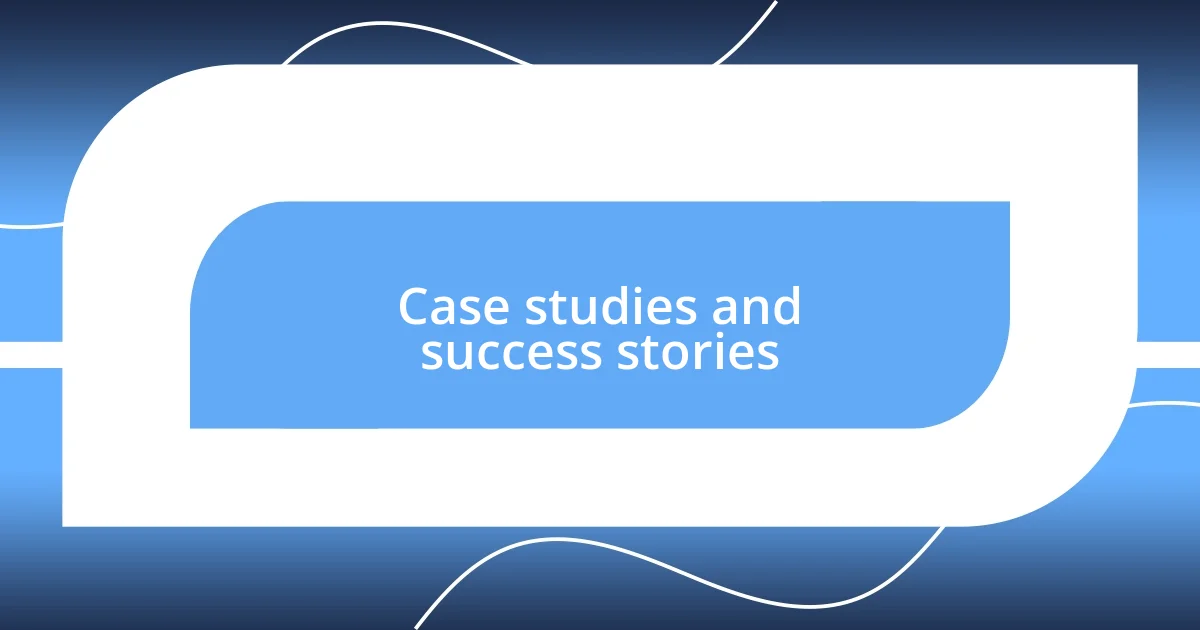
Case studies and success stories
When I first started exploring greywater recycling, I stumbled upon a fascinating case study from a family in California. They transformed their yard into a lush garden using recycled water, reducing their overall consumption by nearly 50%. Their story resonated with me because I often worry about water scarcity. How incredible is it to think that simple changes at home can lead to such significant ecological benefits?
Another inspiring success story comes from a community in Australia that implemented a shared greywater recycling system. Residents banded together to install large storage tanks, allowing them to reuse water from showers and laundry for irrigation. During a visit, I could feel the camaraderie among neighbors, all motivated by a common goal. It made me realize that collaboration could amplify individual efforts and create a richer impact. Wouldn’t it be amazing if more communities embraced such initiatives?
Then there’s the experience of a couple who turned their own struggle with water bills into an opportunity for change. After they installed their greywater system, not only did they notice a dip in expenses, but their garden flourished like never before. Their joy was palpable as they shared photos of their vibrant flowers and vegetables, which they credited to the recycled water. Reflecting on their journey reminded me that the emotional rewards of sustainable practices often transcend the financial benefits, reinforcing our commitment to a greener future.










